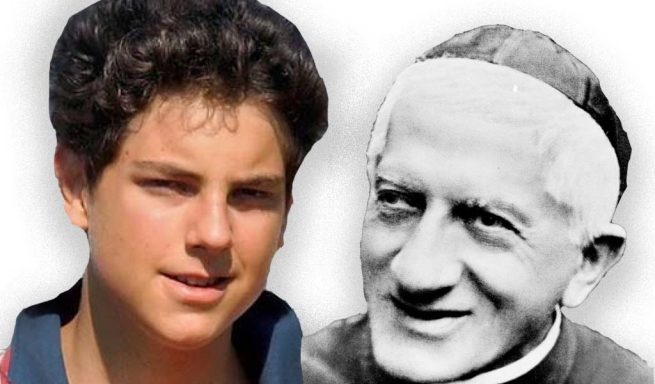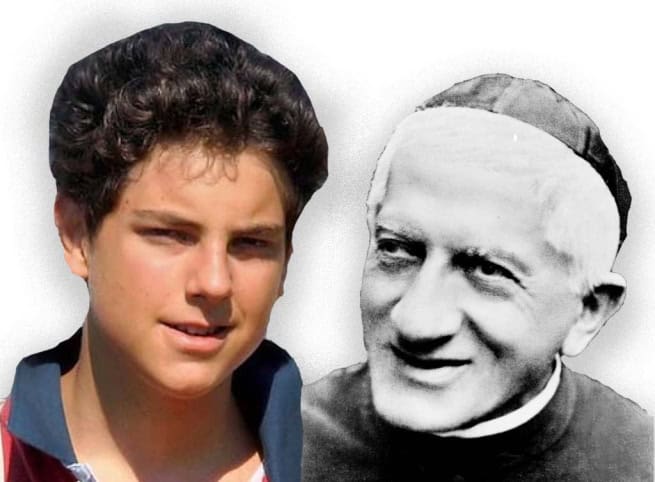(ANS – Vatican City) – In the audience granted on Thursday, 23 May 2024 to Cardinal Marcello Semeraro, Prefect of the Dicastery for the Causes of Saints, Pope Francis approved the decrees leading to the canonisation of Blessed Carlo Acutis, a young lay faithful born on 3 May 1991 in London (England) and died on 12 October 2006 in Monza (Italy); and Father Giuseppe Allamano, founding priest of the Institute of Missions of the Consolata, born in Castelnuovo Don Bosco (Italy) on 21 January 1851 and died in Turin (Italy) on 16 February 1926.
Perhaps for many it was already the case but now it has arrived ‘officially’. Carlo Acutis, already predicted by many as the future “patron saint of the Internet”, will become a saint. Dying at just 15, he was a believer; not as lukewarm as one might think for a boy his age. He believed in God deeply and sincerely. “The Eucharist is my highway to Heaven” the young man often said, thus giving a profound testimony of his faith. At the age of 15 Carlo Acutis has already completed the stages of what it means to have faith, to love the Church and the poor and had expressed his creativity on the web to leave a message – with his exhibition on Eucharistic miracles – that does not fade away by getting lost like many algorithms.
And this despite his suffering caused by the terrible disease that led to his death. The young man, in fact, was struck down by full-blown leukaemia in 2006. In cases like this, discouragement and fear are the feelings that usually prevail in an individual. But not in his case. Because he was a believer until the end, without any hesitation. And not just in words. Because Carlo didn’t forget the least.
His life was that of a normal teenager but at the same time he helped the poor and did not forget to go to Mass every day. The young man was particularly devoted to Our Lady and Saint Francis.
Pope Francis beatified him in 2020, in Assisi, where he now lies, a destination for endless pilgrimages. And this is where the extraordinary story of the miracle that will lead to Carlo’s canonisation begins. Among the many pilgrims at the tomb, on 8 July 2022, on a Friday, was a woman, Liliana, from Costa Rica. She knelt there, prayed and left a letter, words of hope that expressed the worst anguish for a mother. Six days earlier, on 2 July, her daughter fell from her bike one night while returning home to Florence, where she had been studying since 2018. The news from Careggi hospital was crushing. Very severe head trauma, craniotomy surgery, removal of the right occipital bone to decrease pressure, almost no hope of survival.
That 2 July, Liliana’s secretary began to pray to Blessed Carlo Acutis and on the 8th Liliana herself went to Assisi. That same day the hospital said that Valeria had resumed breathing spontaneously, the next day she began moving and partially speaking. From there on this was one of those cases where medical protocols were set aside. On 18 July the CT scan showed that the hemorrhage had disappeared and on 11 August she was transferred for rehabilitation therapy, but after only a week it was clear that complete recovery was one step away. And on 2 September mother and daughter were again in Assisi at Carlo’s tomb to say thank you.
Blessed Giuseppe Allamano
At the same time, the Holy Father also authorised the canonisation of Blessed Giuseppe Allamano: a fellow citizen of Don Bosco, having also been born in Castelnuovo d ‘Asti (today Castelnuovo Don Bosco), he was also the nephew of Don Bosco’s spiritual director, Saint Joseph Cafasso.
As a boy, Giuseppe grew up among the Salesians, and at the age of 22, already a priest, he dreamed of going to the missions, but his health forced him to see to something else. At the age of 29 he was sent to direct the largest Marian shrine in Turin, dedicated to Our Lady of Consolation (the Consolata), and he brought it back to the splendours of the past, so much so that the dream of the missions turned into a greater work, the Consolata Missionary Institute, which he founded in 1901, after waiting for years to obtain official approval. Then, at the request of Pope Pius X, he also established a female branch, the Missionary Sisters of the Consolata.
He sent his first missionaries to Kenya, but+- he felt that it was still not enough, believing that evangelisation should shake up the whole Church. And in 1912, together with other heads of missionary institutes, he spoke to Pius X about the ignorance of the faithful regarding the missions, due to the insensitivity widespread in the hierarchy, proposing to establish an annual Missionary Day, “with the obligation of preaching about the duty and ways of propagating the faith”.
It would take place from 1927. Live he was reproached for caring more about the teaching of trades than the triumphal statistics of baptisms. But for him, the Gospel and human promotion had to be pursued together, with passion and ability.
The acknowledged miracle that will lead to his canonisation occurred precisely in mission territory, in a situation also not unfamiliar to the Salesians: it concerns a local who inexplicably survived a jaguar attack.
John Paul II beatified him in 1990 and when he is canonised he will become the third saint from Castelnuovo.
Source: ANS – “Agenzia iNfo Salesiana”


